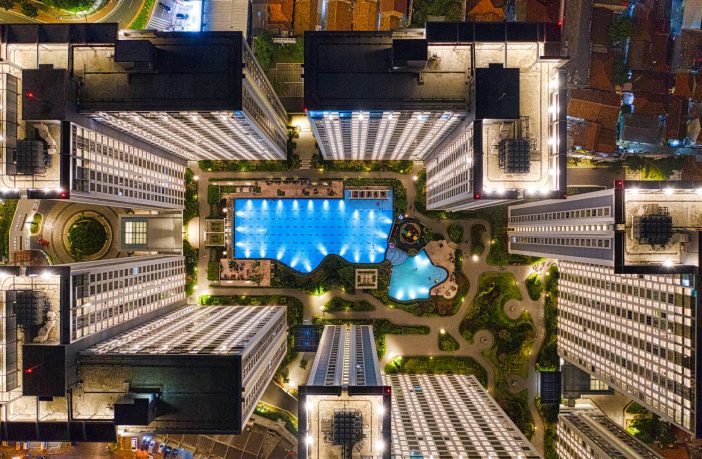- The human scale spans both physical dimensions and sensory perception.
- Designers create spaces and objects like steps, doorways and chairs that are closely aligned to human measurement and how we see the world.
- But as we look beyond the human scale, new ideas and typologies emerge that help us rethink how we conceptualize architecture and build for the future.
Architecture, urbanism, and landscape architecture have all engaged emerging ideas regarding performative ecologies. Unlike buildings, ecologies do no respect borders. They can develop across territories and engender complex systems operating at multiple scales. Ecologies also impact how we regard and value landscapes and larger natural systems. Recently, architects and landscape designers have been exploring ideas on resiliency, conservation, and infrastructure that expand beyond human scales.
Over a decade ago, Swedish architect Magnus Larsson received the LafargeHolcim Prize for the idea to apply biotechnology to stop desert encroachment in Sokoto, Nigeria. This “dune anti-desertification” technique was created in response to the Green Wall Sahara initiative. Larsson describes how sand dunes in Northern Nigeria move southward at a pace of around 600 meters a year. In this way, the Sahara destroys almost two meters of arable land a day, as well as physically pushing people away from their homes.

The plan was to use microorganisms to bind loose sand into sandstone to create stable, dune-like formations and further the desert greening effort. Using Bacillus Pasteurii, he would solidify the sand and help curb the destruction caused by desertification. These dunes would protect new oases in which people displaced by desertification can live. Though its a conceptual approach, the side-effect of this large-scale, territorial idea is a human-scaled, “dune architecture” that would be more precisely controlled. By looking at a broader issue and system in the Sahara, Larsson landed on a typology that rethinks the potential of regional architecture.

Few firms design for architecture as a system like Lateral Office. Creating a critical body of work with ideas like Infrastructural Opportunism, they’ve designed architecture at the scale of infrastructure, and infrastructure at the scale of ecosystems and hemispheres. At the intersection of landscapes, migration and machines, their Caribou Pivot Stations perfectly embody how architects can design beyond the human-scale to inform their work. As the team outlines, the project capitalizes on investments in Arctic research stations across Nunavut and Northwest Territories to address threatened populations of caribou, an integral species in the arctic food web.

Over time, a significant increase in ice layers in the snow pack have made it difficult for caribou to forage for arctic moss and lichen. Likewise, they migrate in the summer to calve and travel back southward in the winter. The team proposed a new research station typology at key points along the caribou’s migratory routes. The station creates a micro-climate of cleared snow and ice, a fresh forage field. The architecture clears an area for easy access of lichen for passing caribou herds. As an elegant architectural proposal to address a problem beyond a human-scale, the architecture takes on a new form.
Through a different lens, Bucharest-based architect Andreea Cutieru explored these ideas in the built environment of machines. As she states, the “rise of new typologies that cater to the machine prompts a conversation about a kind of architecture where human scale is no longer the default measure of space and where the parameters that define the built object do not defer to the human condition, cultural signifiers, and patterns of movement or orientation.” The result is a range of practices evolving to appropriate this kind of architecture.

Building on the work of designers like speculative architect Liam Young and Geoff Manaugh, we can consider autonomous or semi-autonomous machine systems with their own haptic and optical needs. London-based design firm BERG refers to this as the rise of the robot-readable world. In our new geological epoch of the Anthropocene, the scale of machine landscapes and architecture moves beyond humans as artificial intelligence and machine learning conditions the world, reconstructs it, and gives us new ways to inhabit shared spaces.

There is a great deal more we can learn about a human scale by looking at designs that address larger systems. But human scale also refers to how people perceive a city, and if it is about perception, our designs must reflect how each person inhabits the world and the specific systems they are a part of. It is quantities of information informed by the human body, as well as our social institutions. That means that the scale of desert ecosystems, caribou migrations or machine landscapes depends on what each community perceives as a human dimension. As we interact with our environments through physical means, capabilities and limits, there are diverse scales by which we can see our world, and in turn, design for our future.
This article was first published in Arch Daily and is republished with permission.
















